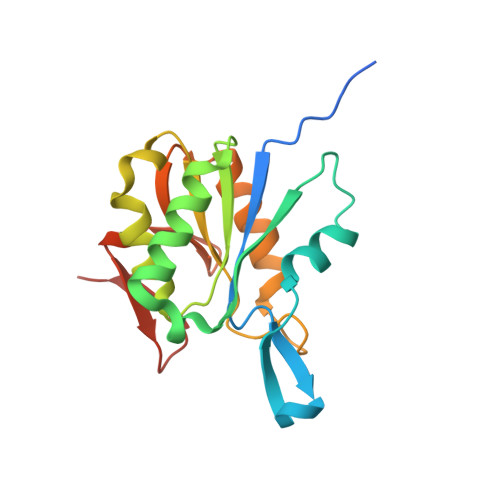RrA, an enzyme from Rhodospirillum rubrum, is a prototype of a new family of short-chain L-asparaginases.
Zhang, D., Czapinska, H., Bochtler, M., Wlodawer, A., Lubkowski, J.(2024) Protein Sci 33: e4920-e4920
- PubMed: 38501449
- DOI: https://doi.org/10.1002/pro.4920
- Primary Citation of Related Structures:
8UOO, 8UOR, 8UOU, 8UOW, 8UP3, 8UP6, 8UP7, 8UP8, 8UP9, 8UPC - PubMed Abstract:
L-Asparaginases (ASNases) catalyze the hydrolysis of L-Asn to L-Asp and ammonia. Members of the ASNase family are used as drugs in the treatment of leukemia, as well as in the food industry. The protomers of bacterial ASNases typically contain 300-400 amino acids (typical class 1 ASNases). In contrast, the chain of ASNase from Rhodospirillum rubrum, reported here and referred to as RrA, consists of only 172 amino acid residues. RrA is homologous to the N-terminal domain of typical bacterial class 1 ASNases and exhibits millimolar affinity for L-Asn. In this study, we demonstrate that RrA belongs to a unique family of cytoplasmic, short-chain ASNases (scASNases). These proteins occupy a distinct region in the sequence space, separate from the regions typically assigned to class 1 ASNases. The scASNases are present in approximately 7% of eubacterial species, spanning diverse bacterial lineages. They seem to be significantly enriched in species that encode for more than one class 1 ASNase. Here, we report biochemical, biophysical, and structural properties of RrA, a member of scASNases family. Crystal structures of the wild-type RrA, both with and without bound L-Asp, as well as structures of several RrA mutants, reveal topologically unique tetramers. Moreover, the active site of one protomer is complemented by two residues (Tyr21 and Asn26) from another protomer. Upon closer inspection, these findings clearly outline scASNases as a stand-alone subfamily of ASNases that can catalyze the hydrolysis of L-Asn to L-Asp despite the lack of the C-terminal domain that is present in all ASNases described structurally to date.
Organizational Affiliation:
Center for Structural Biology, National Cancer Institute, Frederick, Maryland, USA.
















